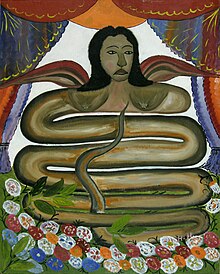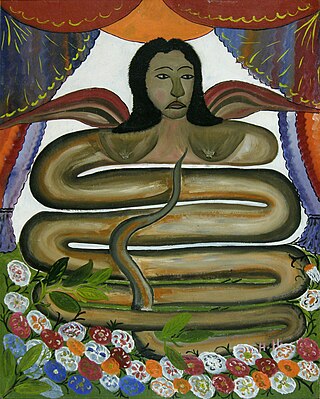
Lwa, also called loa or loi, are spirits in the African diasporic religion of Haitian Vodou. They have also been incorporated into some revivalist forms of Louisiana Voodoo. Many of the lwa derive their identities in part from deities venerated in the traditional religions of West Africa, especially those of the Fon and Yoruba.

Vodun is a religion practiced by the Aja, Ewe, and Fon peoples of Benin, Togo, Ghana, and Nigeria.
A Simbi is a water and nature spirit in traditional Kongo spirituality, as well as in Hoodoo and Haitian Vodou.
Obeah, or Obayi, is a series of African diasporic spell-casting and healing traditions found in the former British colonies of the Caribbean. These traditions derive much from traditional West African practices that have undergone cultural creolization. There is much regional variation in the practice of Obeah, which is followed by practitioners called Obeahmen and Obeahwomen.

The term Voodoo doll commonly refers to an effigy that is typically used for the insertion of pins. Such practices are found in various forms in the magical traditions of many cultures around the world.
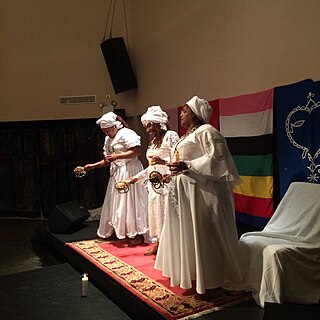
A manbo is a priestess in the Haitian Vodou religion. Haitian Vodou's conceptions of priesthood stem from the religious traditions of enslaved people from Dahomey, in what is today Benin. For instance, the term manbo derives from the Fon word nanbo. Like their West African counterparts, Haitian manbos are female leaders in Vodou temples who perform healing work and guide others during complex rituals. This form of female leadership is prevalent in urban centers such as Port-au-Prince. Typically, there is no hierarchy among manbos and oungans. These priestesses and priests serve as the heads of autonomous religious groups and exert their authority over the devotees or spiritual servants in their hounfo (temples).

Haitian Vodou is an African diasporic religion that developed in Haiti between the 16th and 19th centuries. It arose through a process of syncretism between several traditional religions of West and Central Africa and Roman Catholicism. There is no central authority in control of the religion and much diversity exists among practitioners, who are known as Vodouists, Vodouisants, or Serviteurs.

Espiritismo is a term used in Latin America and the Caribbean to refer to the popular belief that evolved and less evolved spirits can affect health, luck and other aspects of human life.

Sallie Ann Glassman is an American practitioner of Vodou, a writer, and an artist. She was born in Kennebunkport, Maine and is a self-described "Ukrainian Jew from Maine."

Gris-gris is a Voodoo amulet originating in Africa which is believed to protect the wearer from evil or bring luck, and in some West African countries is used as a supposed method of birth control. It consists of a small cloth bag, usually inscribed with verses from an ancestor and a ritual number of small objects, worn on the person.
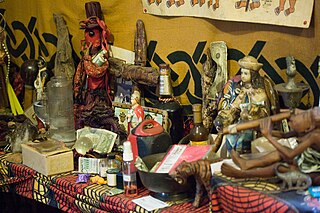
Louisiana Voodoo, also known as New Orleans Voodoo, is an African diasporic religion that originated in Louisiana, now in the southern United States. It arose through a process of syncretism between the traditional religions of West Africa, the Roman Catholic form of Christianity, and Haitian Vodou. No central authority is in control of Louisiana Voodoo, which is organized through autonomous groups.
Vodou drumming and associated ceremonies are folk ritual faith system of henotheistic religion of Haitian Vodou originated and inextricable part of Haitian culture.
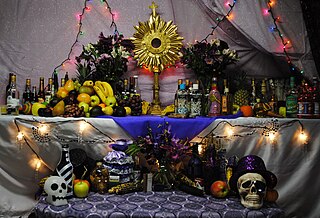
Christian-Vodou relations describe the relationship between Christianity and certain African diaspora religions, including Haitian Vodou and Louisiana Voodoo, and have been marked by syncretism and conflicts, especially in Haiti, but less so in Louisiana and elsewhere.
Marie Thérèse Alourdes Macena Champagne Lovinski (1933–2020), also known by the name Mama Lola, was a Haitian-born manbo (priestess) in the African diasporic religion of Haitian Vodou. She had lived in the United States since 1963.

Haitian Vodou art is art related to the Haitian Vodou religion. This religion has its roots in West African traditional religions brought to Haiti by slaves, but has assimilated elements from Europe and the Americas and continues to evolve. The most distinctive Vodou art form is the drapo Vodou, an embroidered flag often decorated with sequins or beads, but the term covers a wide range of visual art forms including paintings, embroidered clothing, clay or wooden figures, musical instruments and assemblages. Since the 1950s there has been growing demand for Vodou art by tourists and collectors.
Pierrot Barra (1942–1999) was a Haitian Vodou artist and priest, who was president of a Bizango society. He was well-known for his use of diverse materials to create “Vodou Things,” which functioned as charms or altars for the Vodou religion.
In the Caribbean religion of Santería, individuals are required to go through an initiation process to become a full practitioner, known as a santero (male) or santera (female).
Santería is an Afro-Cuban religion that arose in the 19th century.
Bondye, also known Gran Mèt, is the supreme creator god in the African diasporic religion of Haitian Vodou. Vodouists believe Bondye was responsible for creating the universe and everything in it, and that he maintains the universal order. They nevertheless deem him to be transcendent and thus inaccessible to humans, who must instead interact with spirits called lwas.

The Magic Island is a book by American explorer and traveler William Seabrook. First published in 1929 by Harcourt, Brace & Company, The Magic Island is an account of Seabrook's experiences with Haitian Vodou in Haiti, and is considered the first popular English-language work to describe the concept of a zombie, defined by Seabrook as "a soulless human corpse, still dead, but taken from the grave and endowed by sorcery with a mechanical semblance of life—it is a dead body which is made to walk and act and move as if it were alive."
